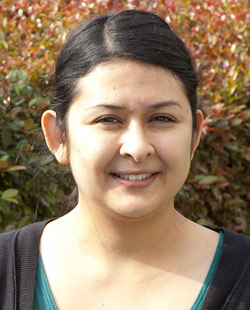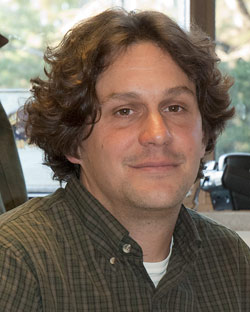Faculty and students team up to change face of science
A campus contingent that included Chancellor Birgeneau headed to San Jose last week for a minority-student conference to increase diversity in the fields of science, technology, engineering and mathematics.
November 2, 2011
A group of 100 UC Berkeley faculty and graduate students made its way to San Jose late last week for a minority-student conference as part of a campus effort to increase diversity and change the face of science.
The Berkeley contingent, which included Chancellor Robert Birgeneau, joined more than 3,500 attendees at the 2011 national conference of the Society for Advancement of Chicanos and Native Americans in Science. The annual meeting of SACNAS, as the organization is known, is the largest conference in the country dedicated to giving a boost to minority students in research, teaching, leadership and policy in science, technology, engineering and mathematics.

MCB grad student Patty Garcia found her path in science. (Roibín Ó hÉochaidh photo)
This year’s event, which wrapped up Sunday, featured four days of scientific-research presentations, professional-development workshops, networking events and cultural and community exhibits. UC Berkeley was one of three “platinum” sponsors.
“Growing up, I saw scientists as being nerdy, old white men,” says Patty Garcia, a sixth-year graduate student specializing in immunology who made the trip to San Jose. “I didn’t know that people like me could follow that path into science.”
Of Mexican-Peruvian heritage, Garcia was a founding member of the student-run campus chapter of SACNAS in 2007.
“For me, going to this conference and seeing so many scientists of color, who looked like me and came from similar backgrounds and offered so much encouragement to go on to graduate school, that’s one of the main reasons I decided to pursue a career path in the sciences,” Garcia says.
SACNAS and beyond
“What we’re doing with SACNAS is trying to reach out to people who haven’t had access and trying to change that because a lot of these students are at the very top in terms of potential,” says Paul Fine, assistant professor and equity adviser in the Department of Integrative Biology.
Of the 10,000 students pursuing doctoral and master’s degrees across more than 100 disciplines at Berkeley in 2010, the majority (4,100 grad students) identify as Caucasian.
Although Berkeley awards more graduate degrees in the sciences to minority students than any other university in the United States, underrepresented minorities account for only about 12 percent of the entire graduate population.
Birgeneau, a physicist, has actively promoted the recruitment and retention of minorities in science, technology, engineering and mathematics, the so-called STEM fields.

Paul Fine is among a core group of faculty leading campus diversity efforts. (Roibín Ó hÉochaidh photo)
“Obviously we can’t solve the huge inequities that exist in the K-12 school system by ourselves, but when you expand your pool to include people of different backgrounds, this is where you get innovation and new ideas, and that’s particularly important in the sciences,” Fine says.
Beyond expanding campus involvement in the national conference, Berkeley’s SACNAS chapter hosts a range of workshops and events designed to help minority students with professional development, fellowship applications, grant writing and exam preparation.
A cross-section of campus sources, from large administrative units to small academic programs, contributed to the $100,000 cost of conference sponsorship as part of the ongoing effort to increase campus diversity.
“Now that we’ve got staff and faculty buying into the effort, I think this conference will be a transformative experience for the campus and the chancellor and faculty really want to keep that moving,” Fine says.
One of a core group of campus faculty driving diversity efforts at Berkeley, Fine takes much of his inspiration from John Matsui, assistant dean of biological sciences.
Matsui co-founded Berkeley’s Biology Scholars Program, which supports non-traditional undergraduate students in the sciences through academic support and advising, paid internships and research opportunities. The program recently announced plans to expand its services to graduate students.
“We should be looking at what we can do to ramp up those efforts,” says Fine, who also sees a real need for programs that get more high-school students involved in field-science projects, such as those run by the Ecological Society of America.
“Programs that get students outside and foster personal connections to natural world are really important in creating a lasting passion for science, especially at younger ages,” Fine says.
Robert Full, a professor of integrative biology at Berkeley and one of the many faculty judges at this year’s SACNAS conference, also serves on the steering committee of the Annual Biomedical Research Conference for Minority Students — the largest professional conference for biomedical and behavioral students.
During that four-day national conference, to take place next week in St. Louis, more than 1,400 students will participate in poster and oral presentations across 12 disciplines in the biomedical and behavioral sciences.

Berkeley SACNAS members enjoy the 2010 national conference. (Courtesy SACNAS at Berkeley)
“It doesn’t end with participation in one conference like SACNAS. There are a lot of other forums out there where you can get involved,” says Full.
“Minority research conferences enhance students’ skills, knowledge and confidence so they can take the next step and connect with people in the fields that most interest them at specialized conferences,” he adds. “This is one critical piece we’ve tried to add to open the pipeline to graduate school.”
Full was instrumental in securing a $4.3 million grant from the National Institutes of Health that will fund the biomedical conference through 2016, and also recently received a grant from the National Science Foundation to support recruitment of exceptional students.
“Diversity is the lifeblood of this university,” Full says. “And it’s not only a social justice issue, we see here how it also gives us an extraordinary competitive advantage.
“When you have a diversity of individuals with different backgrounds and different thoughts, the ability to become creative and to invent skyrockets,” he says. “As a public university, we need to continue to capitalize on that relative to other institutions.”